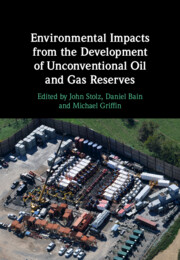Book contents
- Environmental Impacts from the Development of Unconventional Oil and Gas Reserves
- Environmental Impacts from the Development of Unconventional Oil and Gas Reserves
- Copyright page
- Contents
- Figures
- Tables
- Contributors
- Preface
- Part I Overview
- Part II Environmental Analysis
- 5 Air Quality
- 6 Methane and Climate Change
- 7 Water Usage and Management
- 8 Seismicity Induced by the Development of Unconventional Oil and Gas Resources
- 9 Naturally Occurring Radioactive Material (NORM)
- 10 Metal Isotope Signatures as Tracers for Unconventional Oil and Gas Fluids
- 11 Isotopes as Tracers of Atmospheric and Groundwater Methane Sources
- 12 The Microbiology of Shale Gas Extraction
- Part III Case Studies
- Index
- References
10 - Metal Isotope Signatures as Tracers for Unconventional Oil and Gas Fluids
from Part II - Environmental Analysis
Published online by Cambridge University Press: 28 July 2022
- Environmental Impacts from the Development of Unconventional Oil and Gas Reserves
- Environmental Impacts from the Development of Unconventional Oil and Gas Reserves
- Copyright page
- Contents
- Figures
- Tables
- Contributors
- Preface
- Part I Overview
- Part II Environmental Analysis
- 5 Air Quality
- 6 Methane and Climate Change
- 7 Water Usage and Management
- 8 Seismicity Induced by the Development of Unconventional Oil and Gas Resources
- 9 Naturally Occurring Radioactive Material (NORM)
- 10 Metal Isotope Signatures as Tracers for Unconventional Oil and Gas Fluids
- 11 Isotopes as Tracers of Atmospheric and Groundwater Methane Sources
- 12 The Microbiology of Shale Gas Extraction
- Part III Case Studies
- Index
- References
Summary
Metal isotope tracers (e.g., 87Sr/86Sr, 7Li/6Li; 138Ba/134Ba) are being employed worldwide to understand downhole processes and assess the environmental impact of hydraulic fracturing. These isotope signatures can be much more sensitive than geochemical tracers alone in discriminating between contaminant sources. This can be particularly useful when time has elapsed after an event and a contaminant has been substantially diluted, or in being able to quickly detect the intrusion of a brine with high total dissolved solids (TDS) into a protected water resource. In some cases, such as areas with multiple sources of water contaminants and overlapping chemical signatures, a multi-proxy approach is recommended. The combination of element ratio and isotopic tracers (e.g. Sr/Ca and 87Sr/86Sr) or multi-isotope tracers (e.g., 87Sr/86Sr and d7Li) can be used to discriminate between multiple contaminant sources and provide important information about the processes involved in concentrating, mobilizing or retaining a contaminant.
- Type
- Chapter
- Information
- Publisher: Cambridge University PressPrint publication year: 2022

